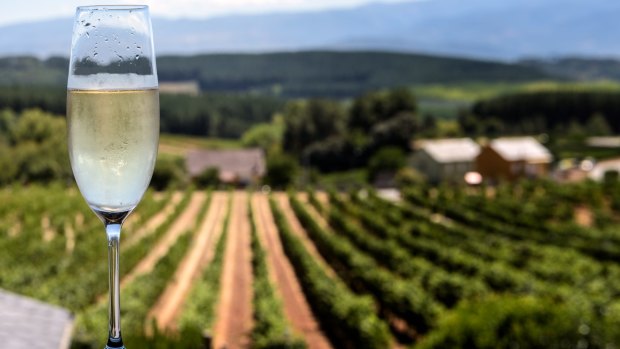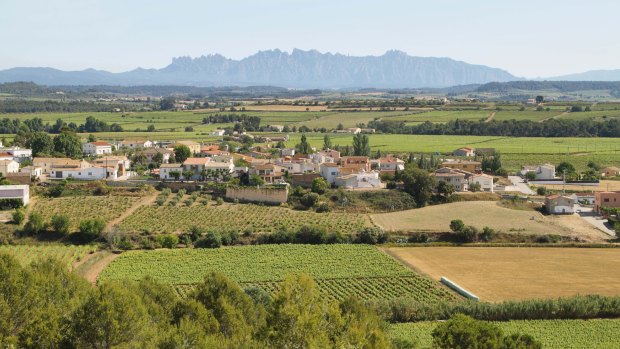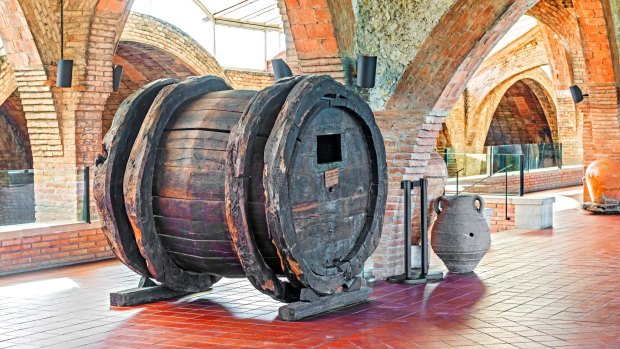This was published 5 years ago
Penedes wine region, Spain: The home of cava, the Spanish version of champagne
By Nina Karnikowski

Penedes is famous for being the home of cava, the Spanish version of champagne, which has a DO (Denominación de Origen), just as champagne does.
If all active travel were like this, I'm certain it's the only kind of travel any of us would ever do. I'm cycling through Spanish wine country, in the beauty spot that is the Penedes region, half-an-hour's drive south-west of Barcelona. When I say I'm cycling, though, it's really my bike that's doing all the work. My four travel compadres and I are on electric bikes, motorised wonders that let you pedal if you feel like it, but give you a boost when you don't; which means all you have to do is hold on and enjoy the ride.
And what an enjoyable ride it is. Penedes, one of Europe's oldest viticultural heartlands, tucked between Mediterranean coastal hills, is an absurdly pretty place, particularly now, in spring. We cycle through the vineyards surrounding San Sadurní d'Anoia village, past vines unfurling fresh shoots, tiny white and yellow wildflowers, and blood poppies lolling along the roadside in thickets alive with bees and butterflies.
Our escort for the morning is local guide Albert Massana. He grew up in Penedes and, since leaving his family's wine and cava business six years ago, has been running these bike and walking tours through the vineyards. He has us stop our pedalling (or lack thereof) in a picturesque spot to help us unravel the history of the region, home to 260 cellars.

Absurdly pretty: Penedes.Credit: Shutterstock
Penedes is famous for being the home of cava, the Spanish version of champagne, which has a DO (Denominación de Origen), just as champagne does. Only those wines produced using the traditional champenoise method can be called cava, the rest are just sparkling wines. Massana tells us cava has been made here since 1872, when a man named Josep Raventos returned from travelling around Europe. He'd been spruiking still wines there, but was so inspired by what he saw in France's Champagne region that he came home to try making his own version. Today, the hugely popular drop is made mainly using the macabeu, xarel-lo and parellada grape varieties, says Massana, which thrive here thanks to the influence of the sun, the proximity of the Mediterranean Sea and the rolling hills, which create three regional microclimates.
Massana must clock the desperate look in our eyes: all this talk of cava has made us thirsty. He swiftly gets us back on our e-bikes and we continue weaving along empty wheat-coloured dirt paths scribbled over hills tilted towards the sun, the craggy Montserrat mountain range rising in the distance, feeling gorgeously lost.
We're not lost, however. Soon, we're parking our e-bikes and farewelling Massana outside Codorniu, the region's most famous vineyard. Dating back to 1551, it's the oldest family business in Spain and the 17th oldest in the world, producing about 45 million bottles of cava every year. We take a quick tour around the opulent grounds, then head into the cellars 30 metres below ground. They're so sprawling we need to take a small train through them, passing millions of dusty, fermenting cava bottles stacked along the walls alongside the odd piece of historic hand-reel machinery. This is not a mere cellar, it's a cava cathedral.

Codorniu, the region's most famous vineyard dates back to 1551.Credit: Shutterstock
Soon we're back above ground, wrapping our lips around glasses of Gran Codorniu rosé cava. It's more delicate than champagne, we decide, the lack of yeasty richness making it fresh, fun and dangerously quaffable.
Not that we have to worry. Our time in the saddle has come to an end. All we need to do now is step into the car and be driven five minutes down the road to lunch at a charming Catalan restaurant housed in a restored 1905 winery called Cal Blay Vinticinc. We're greeted at the door by crisp glasses of cava, one of 120 varietals the restaurant serves. Within minutes of being seated, we're nibbling fresh anchovies and calamari that tells us the sea is close at hand. There's more food to come. For now, though, we're content to simply sit and sip, enjoying the perks of our new favourite form of active travel.
Nina Karnikowski travelled as a guest of Abercrombie & Kent and Cathay Pacific.
TRIP NOTES
MORE
FLY
Cathay Pacific flies from Sydney, Melbourne, Brisbane, Perth, Adelaide and Cairns to Barcelona via Hong Kong. See cathaypacific.com.au
TOUR
Abercrombie & Kent specialises in private and small group journeys to Spain. An eight-day private journey through the north of Spain costs from $14,855 per person twin share. See abercrombiekent.com.au
Sign up for the Traveller Deals newsletter
Get exclusive travel deals delivered straight to your inbox. Sign up now.